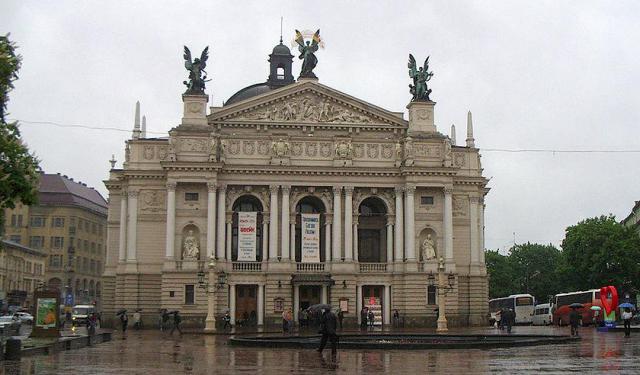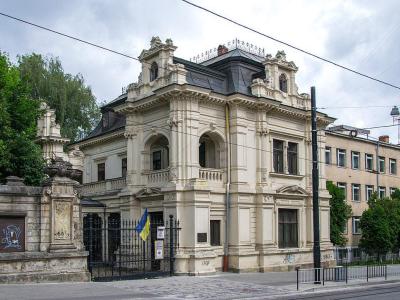
Lviv's Architectural Jewels (Self Guided), Lviv
Lviv has many historical buildings, such as churches and palaces. The city's architecture will show you the best of European styles from various periods. While walking through the streets of Lviv you will see baroque, renaissance and classic architecture. Take this self-guided tour to explore the majestic architecture of Lviv.
How it works: Download the app "GPSmyCity: Walks in 1K+ Cities" from Apple App Store or Google Play Store to your mobile phone or tablet. The app turns your mobile device into a personal tour guide and its built-in GPS navigation functions guide you from one tour stop to next. The app works offline, so no data plan is needed when traveling abroad.
Lviv's Architectural Jewels Map
Guide Name: Lviv's Architectural Jewels
Guide Location: Ukraine » Lviv (See other walking tours in Lviv)
Guide Type: Self-guided Walking Tour (Sightseeing)
# of Attractions: 8
Tour Duration: 2 Hour(s)
Travel Distance: 2.8 Km or 1.7 Miles
Author: vickyc
Sight(s) Featured in This Guide:
Guide Location: Ukraine » Lviv (See other walking tours in Lviv)
Guide Type: Self-guided Walking Tour (Sightseeing)
# of Attractions: 8
Tour Duration: 2 Hour(s)
Travel Distance: 2.8 Km or 1.7 Miles
Author: vickyc
Sight(s) Featured in This Guide:
- St. Anthony's Church
- Korniakt Palace
- Black House
- Bandinelli Palace
- City Hall
- Potocki Palace
- Stefanyk National Scientific Library
- Sapieha Palace
1) St. Anthony's Church
Saint Anthony's Church, established in 1718, is one of the Roman-Catholic churches in Lviv. Though it was rebuilt, it preserved the baroque elements in its architecture and the interior design. The elegant staircase of the church is decorated with beautiful statues. The bell tower, the statues and the staircase are some of the best examples of rococo architecture in Lviv.
2) Korniakt Palace (must see)
The Korniakt Palace on Market Square in Lviv is a prime example of the royal kamienica, or townhouse. The palace was originally built by architect Piotr Barbon. Construction of this elegant Renaissance palazzo was completed in 1580. The Polish-Lithuanian ruler remodeled it into a palatial residence, with spacious rooms and an audience hall. In 1908, the Sobieski Palace became home to the Jan III museum. It is now part of the Lviv History Museum. The royal chambers are used for exhibiting Rococo furniture and clocks, a collection of medallions, and precious silverware.
Sight description based on Wikipedia.
3) Black House
The Black House, or Czarna Kamienica, is a remarkable Renaissance building on the Lviv Market Square. It was built for Italian tax-collector Tomaso Alberti in 1577. The architect was probably Piotr Krasowski. The Lviv Historical Museum has been housed in the Black House since 1926. The façade is lined with sandstone which has darkened over the years to black-brown. The front exhibits some fine decorative ornamentation. Jan Lorencowicz, having acquired the house in 1596, added another store and opened one of the town's first pharmacies on the ground floor. The uppermost store was added in 1884.
Sight description based on Wikipedia.
4) Bandinelli Palace
Palazzo Bandinelli is a late Renaissance townhouse facing Market Square in Lviv,. It was built in 1589 by a pharmacist Jarosz Wedelski, and in 1634 it was bought by a Florentine merchant, Roberto Bandinelli, known as the founder of the first post office in eastern Galicia. That office was housed in the building from 1629 onward, and was closed in a few years when the business became unprofitable. The house was considerably renovated in 1737-1739. In the 19th century Palazzo Bandinelli was used as a bookshop and a meeting place for the local literati. The Soviet authorities gave the house to the Lviv Historical Museum which had the building thoroughly repaired and restored.
Sight description based on Wikipedia.
5) City Hall (must see)
City Hall of Lviv is set in the middle of the famous Market Square. This old building dates back to the 14th century. It has a high tower that was added in 1619. Later the tower was rebuilt in the style of Viennese Classicism. The City House is a brick building with an inner yard. There are sculptures of lions at the entrance of the City Hall; they are the symbols of Lviv.
6) Potocki Palace (must see)
The Potocki Palace in Lviv was built in the 1880s as an urban seat of Alfred Józef Potocki, Minister-President of Austria. No cost was spared to make it the grandest nobleman's residence in the city. The French architect Louis de Verny elaborated all of Beaux-Arts stylisic devices to produce a hypertrophied imitation of a French hôtel particulier. An open, parklike setting was scored to give the mansion a sense of depth. At the turn of the century the parkland gave way to a network of apartment buildings.
The palace itself was adapted for holding wedding ceremonies in 1972 and subsequently underwent restoration. In the 2000s the President of Ukraine appropriated the palace as one of his residences. Some of its architectural motifs were borrowed by the next-door exhibition hall (inaugurated in 1996).
The palace itself was adapted for holding wedding ceremonies in 1972 and subsequently underwent restoration. In the 2000s the President of Ukraine appropriated the palace as one of his residences. Some of its architectural motifs were borrowed by the next-door exhibition hall (inaugurated in 1996).
Sight description based on Wikipedia.
7) Stefanyk National Scientific Library
The Stefanyk Scientific Library of the National Academy of Science of Ukraine is a beautiful building that is an example of Classicism architecture. The building was built in 1651—1677 as a monastery building in Baroque style. Today you can see the Corinth columns and portico. There is a monument to Stefanyk at the entrance to the library.
8) Sapieha Palace
The Sapieha Palace is an architectural monument of Lviv. It was built as a Chateaubriand mansion in 1870s. During the Soviet times the palace was used as a school. In the 1990s the palace was restored and the office of preserving the historical and architectural monuments of the city is housed there. The palace is elegantly decorated and is clearly seen from the street as it has an ornamental iron gate.
Walking Tours in Lviv, Ukraine
Create Your Own Walk in Lviv
Creating your own self-guided walk in Lviv is easy and fun. Choose the city attractions that you want to see and a walk route map will be created just for you. You can even set your hotel as the start point of the walk.
Historical Churches
Lviv is an old beautiful city with many churches in impressive buildings with majestic interiors. Some of the churches are architectural monuments listed as UNESCO World Heritage Site. Take this self-guided tour to see the most beautiful churches of Lviv.
Tour Duration: 1 Hour(s)
Travel Distance: 1.7 Km or 1.1 Miles
Tour Duration: 1 Hour(s)
Travel Distance: 1.7 Km or 1.1 Miles
Lviv Introduction Walking Tour
The largest city in the western part of Ukraine, Lviv stands out in its historic beauty and deservedly holds a place on the UNESCO World Heritage List. To find out exactly why, follow this self-guided tour and discover the most notable historic and architectural sights of the city.
Tour Duration: 3 Hour(s)
Travel Distance: 3.6 Km or 2.2 Miles
Tour Duration: 3 Hour(s)
Travel Distance: 3.6 Km or 2.2 Miles
Lviv's Monuments and Statues
The city of Lviv has many historical monuments that make it a living history. Monuments and statues are dedicated to outstanding Ukrainians that contributed to the cultural development of Lviv and played important roles in its history. Take this self-guided tour to discover the rich history of Lviv through its great monuments and statues.
Tour Duration: 2 Hour(s)
Travel Distance: 4.3 Km or 2.7 Miles
Tour Duration: 2 Hour(s)
Travel Distance: 4.3 Km or 2.7 Miles
The Most Popular Cities
/ view all











